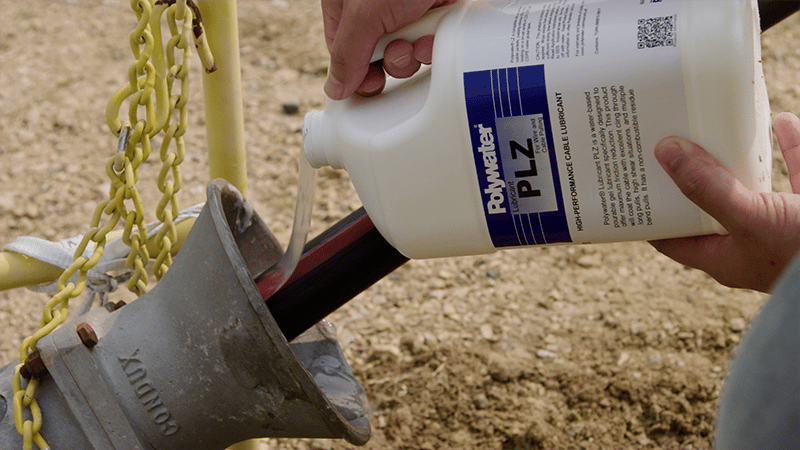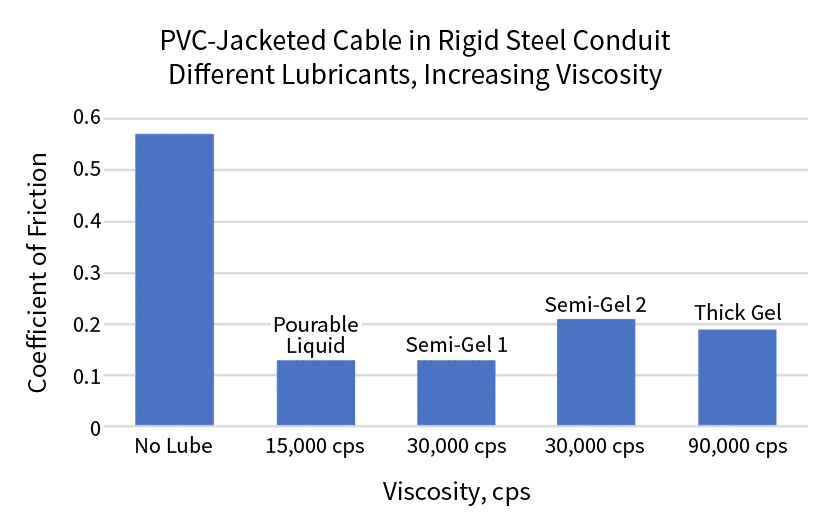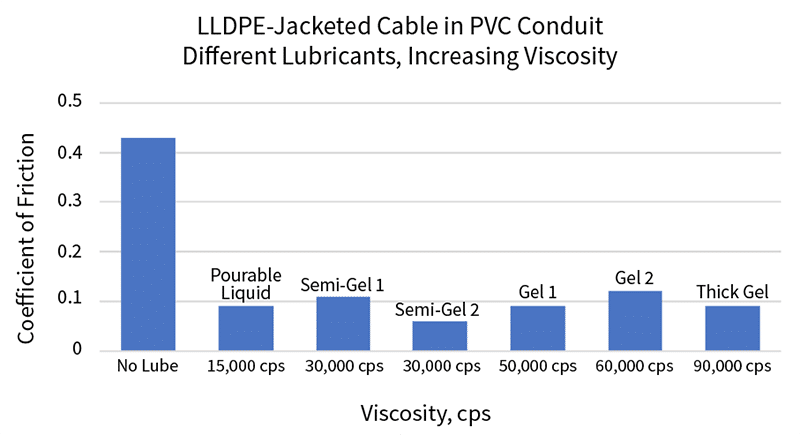A “Pour” Explanation
Polywater® manufactures both liquid and gel cable pulling lubricants. Which type is better? Why offer both? When should one be used versus the other? This article presents Polywater's extensive research on pulling lubricant viscosity and application to help answer these questions.
Liquid versus Gel
Let’s first establish our terms. What is a liquid? In the specialized field of cable pulling lubrication, Polywater has adopted a simple definition to answer this otherwise complex scientific question: A liquid lubricant is one that will pour through a one-inch (2.5-cm) spout. If it’s too thick to pour, it’s not a liquid but rather a gel.
Viscosity is a scientific definition of liquid “thickness”. It is part of the larger science of rheology, the study of how materials flow. Viscosity can be measured in centipoise (cps) using a rotational viscometer that measures shear stress versus shear rate. Liquids such as paints will thin under shear as you coat the wall surface but have a higher viscosity when the shear is removed. This characteristic keeps the paint from dripping down the wall.
We define liquid pulling lubricants as those with viscosities ranging from 1 to 20,000 cps at 10 rpm (rotations per minute) using a rotational viscometer. For reference, water has a viscosity of 1 cps, while honey is at 50,000 cps. Most commercially available liquid pulling lubricants are relatively thick liquids with viscosities from 1,000 to 15,000 cps.

Why Does Rheology Matter?
Application is the key. In cable pulling lubrication, it’s as important as coefficient of friction (COF). Why? Successful application directly affects the quality of lubricant coating. It should be easy to apply and act to “self-spread” between the cable and conduit surfaces. Lubricant that coats and stays between the cable and conduit throughout the pull is far more effective at lowering friction.
| Related Content: Q&A: The Effect of Pulling Lubricants on High Frequency Data Cable |
Cable pulling presents a unique challenge: spreading lubricant on the cable and throughout the entire conduit—especially around bends—and keeping it there for the duration of the pull. This is why specialty cable pulling lubricants exist. They address not only friction reduction, but also all the other critical characteristics: compatibility, toxicity, ecology, economy, residue combustibility, and especially the major deciding factor of application.
Viscosity tends to dictate the way lubricant is applied. Depending on the cable installation setting, different forms may be easier to use. Easy application results in more successful application.
What Are the Considerations?
Many gel or paste lubricants with a viscosity of >20,000 cps may pour literally, but not practically. They flow too slowly to be poured efficiently. These lubricants are generally scooped from a pail and hand-applied or pumped with specially designed high-viscosity pumps. Gel lubricants cling well to vertical surfaces even in a thick film, while liquids flow easily with gravity and are better suited to horizontal installations. Thus, consider the advantages of each type:
Liquid Lubricants:
-
- Popular for underground work where lubricant can be poured into a vertical flexible conduit, stub-up, or feeder tube (elephant trunk).
- Those with stringy character can pull themselves through bends to all parts of the duct.
- Better for long pulls with lightweight fiber cable.
- Perfect for gravity feed lubrication and various lubricant applicator devices.
- Used in Polywater’s exclusive “thin-film technology” lubricants (Types SPY and FTTx), which are applied via spray bottles or saturated wipes.
Gel Lubricants:
-
- Preferred in overhead application where dripping is minimized.
- Used in manual applications where lubricant is scooped and hand applied.
- Used in Polywater’s exclusive Front End Pack™ bags, which allow the gel to slowly ooze as it’s pulled in front of the cable.
- Used in Polywater’s exclusive Front End Pack™ bags, which allow the gel to slowly ooze as it’s pulled in front of the cable.
- Enable greater quantities to be applied to the cable for longer pulls.
- May be pumped with suitably designed pumps.
| Related Content: The Polywater® Friction Table: Personal Perspectives |
Which is Slipperier?
Our research shows little difference in friction performance between liquids and gels when comparing lubricants of similar chemical composition. Lubricant composition along with the cable and duct substrate are the key influences on COF value. Values in the chart below are produced from Polywater’s Friction Table Test. The Friction Table method is described in more detail in our white paper. This test is typically run with a normal or sidewall force of 200 lbs/foot (2.9 kN/m). This test does not measure the ease of application or the effectiveness of the coating through long cable pulls with multiple bends. It is a good indicator of COF reduction.
These data show that cable lubricants are effective at lowering COF. The results graphed below also show that viscosity is an independent factor and does not directly affect the COF.
Graph 1: Friction Table Test

| Related Content: Hawaiian Electrical Company (HECO) and the Pearl Harbor Cable Pull |
In the second graph, another cable jacket and conduit combination are shown with another selection of cable lubricants.
Graph 2: Multi-Bend Friction Test

Never Say Never
Keep in mind that there are no hard-and-fast rules with lubricant application. The advantages listed here are merely guidelines. The truth is that liquid lube is often applied by hand. Skilled workers learn to coil stringy liquids such as Polywater PJ around their hands like spaghetti on a fork. This trick allows them to hold and apply greater quantities with less mess. It’s not that it can’t be done; it’s that it’s hard to do so without waste and mess, particularly with very thin, non-stringy lubricants. Similarly, some gels can be poured, although “plopped” may be a better description. Again, waste, mess, and proper distribution of the lube are the potential challenges.
| Related Content: Planning Cabling Projects Improves Success and Safety |
Summary
The choice between a liquid and gel cable pulling lubricant is thus primarily one of application and convenience. Consider the particulars of the installation. Is it vertical or horizontal? Is it long or short? Is it heavy electrical cable, or lightweight fiber? How will the lubricant be applied; by hand, by pump, by pouring, by spraying, by wiping, or by applicator device? These criteria lead to the optimal choice. Liquids are easier to pour, spray, or wipe. Gels are easier to scoop by hand. Both can be pumped, but free-flowing liquids require less effort, so not all pumps can handle thick gels.
After the basic decision of liquid vs. gel, the next step is the choice of chemistry, which addresses friction reduction, compatibility, additional rheology factors (cable coating and wetting properties), residue combustibility, shear resistance, testing, approvals, and more—all topics of future research articles.